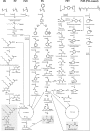Microbial Degradation and Valorization of Plastic Wastes
- PMID: 32373075
- PMCID: PMC7186362
- DOI: 10.3389/fmicb.2020.00442
Microbial Degradation and Valorization of Plastic Wastes
Abstract
A growing accumulation of plastic wastes has become a severe environmental and social issue. It is urgent to develop innovative approaches for the disposal of plastic wastes. In recent years, reports on biodegradation of synthetic plastics by microorganisms or enzymes have sprung up, and these offer a possibility to develop biological treatment technology for plastic wastes. In this review, we have comprehensively summarized the microorganisms and enzymes that are able to degrade a variety of generally used synthetic plastics, such as polyethylene (PE), polystyrene (PS), polypropylene (PP), polyvinyl chloride (PVC), polyurethane (PUR), and polyethylene terephthalate (PET). In addition, we have highlighted the microbial metabolic pathways for plastic depolymerization products and the current attempts toward utilization of such products as feedstocks for microbial production of chemicals with high value. Taken together, these findings will contribute to building a conception of bio-upcycling plastic wastes by connecting the biodegradation of plastic wastes to the biosynthesis of valuable chemicals in microorganisms. Last, but not least, we have discussed the challenges toward microbial degradation and valorization of plastic wastes.
Keywords: biodegradation; depolymerase; plastic wastes; protein engineering; synthetic biology; valorization.
Copyright © 2020 Ru, Huo and Yang.
Figures


Similar articles
-
Biodegradation of plastics for sustainable environment.Bioresour Technol. 2022 Mar;347:126697. doi: 10.1016/j.biortech.2022.126697. Epub 2022 Jan 11. Bioresour Technol. 2022. PMID: 35026422 Review.
-
Plastic wastes biodegradation: Mechanisms, challenges and future prospects.Sci Total Environ. 2021 Aug 1;780:146590. doi: 10.1016/j.scitotenv.2021.146590. Epub 2021 Mar 19. Sci Total Environ. 2021. PMID: 34030345 Review.
-
MIXed plastics biodegradation and UPcycling using microbial communities: EU Horizon 2020 project MIX-UP started January 2020.Environ Sci Eur. 2021;33(1):99. doi: 10.1186/s12302-021-00536-5. Epub 2021 Aug 21. Environ Sci Eur. 2021. PMID: 34458054 Free PMC article.
-
Plastic biodegradation by in vitro environmental microorganisms and in vivo gut microorganisms of insects.Front Microbiol. 2023 Jan 6;13:1001750. doi: 10.3389/fmicb.2022.1001750. eCollection 2022. Front Microbiol. 2023. PMID: 36687617 Free PMC article. Review.
-
[Degradation of petroleum-based plastics by microbes and microbial consortia].Sheng Wu Gong Cheng Xue Bao. 2021 Oct 25;37(10):3520-3534. doi: 10.13345/j.cjb.210399. Sheng Wu Gong Cheng Xue Bao. 2021. PMID: 34708608 Review. Chinese.
Cited by
-
Diversity of marine bacteria growing on leachates from virgin and weathered plastic: Insights into potential degraders.Environ Microbiol Rep. 2024 Jun;16(3):e13305. doi: 10.1111/1758-2229.13305. Environ Microbiol Rep. 2024. PMID: 38923399 Free PMC article.
-
Microplastics in aquatic systems, a comprehensive review: origination, accumulation, impact, and removal technologies.RSC Adv. 2022 Oct 4;12(44):28318-28340. doi: 10.1039/d2ra04713f. eCollection 2022 Oct 4. RSC Adv. 2022. PMID: 36320515 Free PMC article. Review.
-
Ethylene glycol metabolism in the poly(ethylene terephthalate)-degrading bacterium Ideonella sakaiensis.Appl Microbiol Biotechnol. 2022 Dec;106(23):7867-7878. doi: 10.1007/s00253-022-12244-y. Epub 2022 Oct 27. Appl Microbiol Biotechnol. 2022. PMID: 36289066
-
Plastic Degradation by Extremophilic Bacteria.Int J Mol Sci. 2021 May 25;22(11):5610. doi: 10.3390/ijms22115610. Int J Mol Sci. 2021. PMID: 34070607 Free PMC article. Review.
-
Evaluation of the Biodegradation Efficiency of Four Various Types of Plastics by Pseudomonas aeruginosa Isolated from the Gut Extract of Superworms.Microorganisms. 2020 Sep 2;8(9):1341. doi: 10.3390/microorganisms8091341. Microorganisms. 2020. PMID: 32887431 Free PMC article.
References
-
- Aguado R., Olazar M., San José M. J., Gaisán B., Bilbao J. (2002). Wax formation in the pyrolysis of polyolefins in a conical spouted bed reactor. Energ. Fuel. 16 1429–1437. 10.1021/ef020043w - DOI
-
- Alariqi S. A., Kumar A. P., Rao B. S. M., Singh R. P. (2006). Biodegradation of γ-sterilised biomedical polyolefins under composting and fungal culture environments. Polym. Degrad. Stab. 91 1105–1116. 10.1016/j.polymdegradstab.2005.07.004 - DOI
-
- Albertsson A. C. (1978). Biodegradation of synthetic polymers. II. A limited microbial conversion of 14C in polyethylene to 14CO2 by some soil fungi. J. Appl. Polym. Sci. 22 3419–3433. 10.1002/app.1978.070221207 - DOI
Publication types
LinkOut - more resources
Full Text Sources
Other Literature Sources
Miscellaneous

